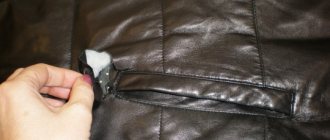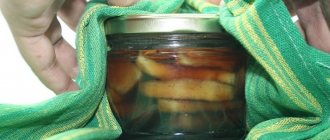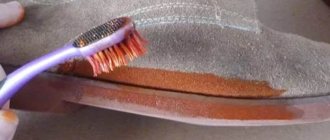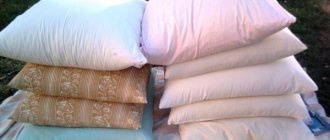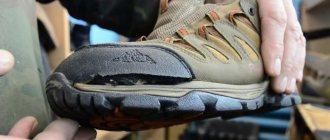Why thermal appliqués have been so popular for decades. This is not at all surprising. Firstly, the use of thermal stickers does not require significant costs and allows you to turn a completely ordinary outfit into a designer item. And secondly, you don’t have to have superpowers to stick a patch on with an iron.
SEWING
Sewing on chevrons and patches is one of the most popular methods of attaching to fabric. This method is often used by the military, who sew distinctive insignia onto the sleeves and pockets of uniforms.
The most reliable and correct type of sewing is machine stitching. This can be done when the product does not have a lining, and it is also possible to operate a sewing machine.
If you still need to sew it on ready-made clothes or clothes with a lining, the outer fabric is fixed together with the lining and the chevron is sewn through. In such cases, it is important to prevent the fabric from becoming distorted - this will lead to the item becoming unwearable.
Special equipment reliably and efficiently attaches the chevrons without tightening the fabric or damaging the useful part of the patch itself. Very often, sewing is used together with gluing.
How to properly stick a thermal adhesive on a jacket?
Turn on the iron at full power, wait for it to warm up and apply it to thick fabric on top of the sticker for 1-2 minutes. Remove the iron and fabric. The thermal adhesive should fit tightly to the Bolognese surface, decorating the down jacket or Bolognese jacket.
Interesting materials:
How to add a Gazpromneft bonus card to your phone? How to add a Yandex card to Google Pay? How to add a Gazprom card to Wallet? How to add a Tatneft loyalty card to Yandex gas stations? How to add a metro card to Wallet? How to add a world map? How to add a card to the Post Bank application? How to add a card to Sberbank online on iPhone? How to add a card to an NFC phone? How to add cards to iPhone?
REMOVABLE MOUNT
Another popular fastening method is adhesive tape or Velcro tape. One part of the Velcro is sewn to the chevron, and the other to the clothing in the right place. This method is good because, if necessary, you can easily remove the embroidery from the item for washing. This method is also convenient when stripes in the same place can change in content, but remain the same in size.
Types of fastening are selected depending on many factors: convenience, possibility of replacement, durability and wear resistance... We should not forget the individual preferences of people.
In any case, no matter which method you choose, remember that the chevron should not form folds and fit tightly to the product. The quality and appearance of decals depend not only on the method of their attachment, but also on the manufacturing method. Embroidery will always remain the highest quality, wear-resistant, neat and beautiful. An embroidered chevron will serve you for a long time, and you will always be satisfied with its appearance.
Stages of creating a sample embroidered patch
Any patch, and this one is no exception, starts with a layout. The layout for developing an embroidery design for an embroidery machine can be provided in both vector and raster format. In this case we were given a vector.
We made a machine embroidery design in the required sizes based on the resulting vector .
Next, the prepared design is loaded into the embroidery machine, the required color threads are inserted, the base for embroidery and stabilizers are hooped. The machine starts and the embroidery process begins.
After the embroidery is finished, we roughly trim it around the perimeter with allowances. Cut a suitable size piece from the roll of glue (on the left in the photo).
Turn on the heat press and apply a layer of adhesive to the back of the patch, press for a few seconds so that the glue adheres to the patch.
Next, the patch along with the adhesive layer is cut around the perimeter. In this isolated case, we cut by hand using scissors. But when printing, it is most convenient and accurate to cut with a laser.
This is what the patch on the back looks like. The adhesive is covered with a protective layer of siliconized paper.
All that remains is to place such a patch in the desired place on the clothing and glue it with an iron.
The time it takes to create such a sample depends on the workload of production. We usually do it in 1 business day.
The cost of creating a sample of similar complexity is 700 rubles.
It is worth keeping in mind that patches completely covered with stitches are one of the most expensive types of patches (chevron). And the more letters, strokes, drawings and other elements they have on top of the embroidered background, the more expensive they are. But the appearance of such stripes is more advantageous and respectable than those on a fabric basis.
How to properly sew shoulder straps onto a cadet uniform?
Instructions on how to attach a chevron to a cadet uniform:
- Determine the center of the shoulder seam. ...
- From the center of the seam, use soap or chalk to draw a line down the longitudinal thread.
- Measure 8 cm and draw a perpendicular line at this level.
- Align the top edge of the chevron with the perpendicular line.
- Trace the patch
.
Interesting materials:
How to make slime from ordinary plasticine? How to make Slime from clear glue and baking soda? How to make slime from ball plasticine? How to make slime from liquid stationery glue? How to make Slime with an activator? How to make Slime at home without PVA glue? How to make softening hand cream at home? How to make snow from foam plastic? How to make a snow globe with glycerin? How to make asparagus from soybeans?
How to glue a patch with an iron
There are two options for gluing a patch to fabric.
If your patch already contains an adhesive base, proceed as follows:
- The material on which we will glue the patch must be placed and properly straightened on a hard surface so that there are no creases.
- Heat up the iron and turn off the steam option.
For better glue melting and adhesion to the surface, it is better to heat the iron to maximum. Remember that not all fabrics can withstand this temperature load. Therefore, we check whether the material is damaged in any inconspicuous area.
- We remove the protective film from the applique and place it face up on the place where we plan to glue the patch. If the thermal patch is large, it is better to secure it to the fabric with pins.
- Cover the top of the patch with gauze or paper and press firmly with an iron. Iron for 30 seconds. To glue the part well.
- We wait 2 minutes and repeat the operation from the wrong side.
For adhesive-based patches, cotton fabrics are better suited, but not coarse knitted wool. In addition, Boucle, leather, and velor are also not suitable for gluing the thermal decal.
We recommend watching the video instructions:
If your patch does not have an adhesive base. No specialized equipment is needed to glue such an applique. For this we need thermal film. When choosing thermal film, you need to pay attention to the types of adhesive base.
There are several types of glue:
- Polyamide glue. It has high elasticity and sticks in steam mode. It tolerates washing and dry cleaning well. But it holds less firmly on synthetic fabrics with special impregnations.
- Polyethylene glue is compatible with a wide range of fabrics and is suitable for gluing small parts. Glues without steam.
- Polyester glue is more suitable for synthetic fabrics. Glues without steam. Reacts well to washing and dry cleaning.
So, to glue such a thermal patch:
- Take thermal film of the required size. Apply the glossy side to the applique from the wrong side.
- Heat the iron and iron it through paper or gauze with the matte side of the thermal film facing up.
- Trim off the excess thermal film along the edge of the patch. And check how tightly it is adhered to the patch. Try peeling off the film. She must sit tight.
- If everything is in order, repeat the steps from the first point.
How to glue chevrons correctly?
According to the order of the Ministry of Internal Affairs of Russia No. 575, chevrons are sewn onto the sleeves of the dress at a distance of 8 cm from the edge of the shoulder. A chevron is sewn onto the left sleeve indicating membership in the Ministry of Internal Affairs of Russia, and on the right sleeve there is a chevron designating the service of a police/justice officer. You can add Velcro to the chevrons.
Interesting materials:
How much does an MRI of the spine cost on average? What is the average cost of a one-room apartment in Moscow? How much does a pastry chef earn on average? How long do rabbits live on average? How long do dogs live on average? How long do you cook butter before frying? How long does it take to cook wild mushrooms? How long to cook broccoli for freezing? How long to cook beans without pre-soaking? How long should you cook mushrooms after picking?
Why do we need Tutorials from Pyaterochka?
During the promotion, all your favorite superheroes from Marvel comics and films will be waiting for you in the form of patches and stickers. Stickers are small stickers that can be attached even to your backpack and thereby stand out from the crowd.
Interesting materials:
How to disable notifications from sites in Opera? How to disconnect calls from MTS Belarus? How to disable a second Google account? How to disable item drops in Minecraft? How to disable Windows Hello? How to disable tasks in GTA 5? How to disable call barring Beeline Kazakhstan? How to turn off sound in one program? How to turn off sound notifications on VKontakte? How to open an apk file for editing?
How to properly attach stripes?
Gluing the patch with an iron: instructions in 6 steps
- Decide on the place where you need to attach it. ...
- Make sure that the area where the patch is attached is level. ...
- Adjust the iron temperature. ...
- If there is a protective paper layer on the back of the patch, remove it.
Interesting materials:
How to translate the word trembling? How to translate the word Hedgehog? How to translate the word gram? How to translate the word Ilyin? How to translate the word iodine? How to translate the word Young? How to move the word Iva to another line? How to move the word kilogram from one line to another? How to translate the word cool? How to transfer the word boys into syllables?
Patches An easy way to personalize and update old items
Today, in the age of the mass market, we increasingly want something special and personalized, so that it is at least a little different from everyone else. One of the easiest and fastest ways to update and decorate an item is with stripes and patches for clothing. And today’s post is about them: where and how to glue patches. Patches are a good way not only to personalize your new things, but also to bring old ones back to life. Maybe you have an old denim jacket, a T-shirt with a small hole, or a shirt with a stain lying around in your closet? Or you have a simple cotton bag and want to make it more interesting. Then stripes or patches for clothing will come to your aid.
I bought my patches from Mango. I liked the color scheme: black, red, gold and white fit perfectly into my wardrobe. Their quality is also good, the embroidery is done neatly. They also have these space patches, these Gucci-style floral ones, beaded patches with butterflies and birds, and these shiny patches.
Mango patches
You can also find interesting patches from other companies: on the currently popular theme of feminism, funny patches, patches with an eye, with a green leaf, with a tropical landscape, with a mermaid and a rainbow. Or just visit your local sewing supply store, you can always find a large selection there.
I decided to use these patches to personalize a simple cotton tote that I always carry with me, either for grocery shopping (constantly buying or taking a bag is a huge detriment to our planet) or for extra baby items I need to take with me. I also bought the bag from Mango. The quality of the cotton is very good: it is dense and has a texture similar to linen. This bag, by the way, is participating in a charity event. All money from its sale will be directed to the Fero Cancer Foundation to support research in the field of oncology. I like it when when you buy something (if you have to make that purchase anyway) you can help or support someone.
Cotton bag Mango
The patches are easily glued with a hot iron, which needs to be applied for 15 seconds. I recorded a short video for you about how I glued the patches. I really liked the result! And I decided to use the remaining two patches either on a white T-shirt or on a military jacket. I'll tell you later





